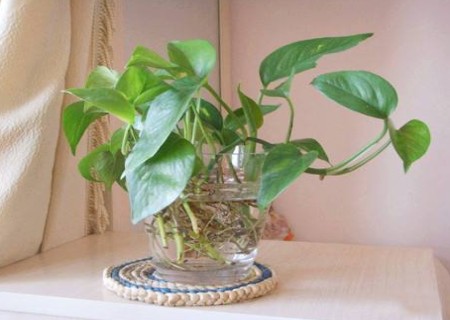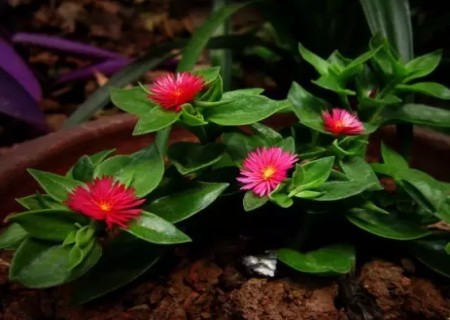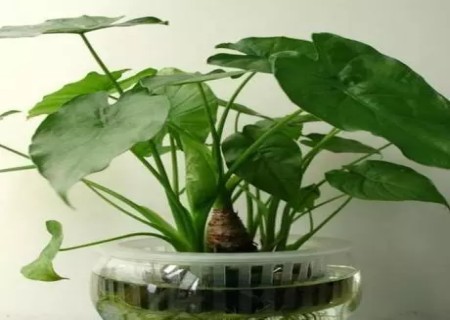Step diagram of hydroponic culture of green turnip
Hydroponic culture is clean and hygienic, and it is more ornamental. Therefore, hydroponic flower culture is the first choice for many flower lovers. Green pineapple is a popular foliage plant, which can absorb formaldehyde, purify the air, and is very easy to feed. Can be placed in the windowsill, balcony, can also be used to decorate the corner or bookshelf, the corner of the coffee table. Green pineapple can be cultivated in soil or in water. Today, I would like to introduce the method of hydroponic culture that I can easily learn.

Steps / methods of hydroponics:
1. Choose the appliance
According to the variety and shape of green pineapple, choose substitute bottles, pots, vats and other utensils that can complement each other, and purchase or process self-made instruments according to the principles of selecting hydroponic instruments mentioned above, so as to make them use appropriately and elegantly. Never take the utensils used casually and use them indiscriminately, so as not to affect the image of hydroponic green pineapple and the beauty of interior decoration. To achieve unity and harmony between utensils and flowers and the living environment, in order to achieve a more ideal ornamental effect.
2. Remove the soil and wash the roots
Soil cultivation is organic nutrition, but after changing to water culture, it is completely changed to inorganic nutrition cultivation, and the organic matter attached to the soil and roots should be strictly cleaned so as not to affect the normal growth of hydroponic flowers and the infection of diseases and insect pests.
The method of washing the roots is as follows: dig out the selected flower plants from the soil or gently pour them out from the flowerpot, first gently lift the branches with the right hand, gently support the root system with the left hand, change the right hand to gently shake, and slowly pat, so that the root soil falls off and reveals all the roots. Then soak in water for 15-20 minutes, gently wash the root with hands, after 2-3 times of water cleaning, until the root is completely soil-free, the water for washing the root is clear and transparent and does not contain sediment. However, it should be noted that some flowers have hard roots and twisted joints, and a lot of soil is in the cracks, which can be dug out with bamboo sticks or sticks and screwdrivers if necessary. There must be no soil left, which is one of the important links in the success of hydroponics, and we must not be negligent.
After washing the soil, old roots, diseased roots and old leaves and yellow leaves can be cut off properly according to the growth of flower roots. Because the root of hydroponic green radish is also an important part of ornamental, the beauty of its shape should also be considered when arranging the root system. After pruning the roots and leaves, they should be washed again in clean water to wash away the residue of root hair left when they are cut, so as to avoid pollution caused by bringing them into hydroponic equipment.
3. Root disinfection
After the flower roots are cleaned, 0.1% potassium permanganate aqueous solution is prepared and placed in plastic or enamel pots. The amount of solution can be determined according to the number of flowers soaked, and several or more flowers can be soaked at one time, with submerging all the roots as the standard. After soaking for 10-15 minutes, take out the flower plant solution, then wash it in clean water and plant it. Note that the root disinfection time should not be too long or too short, and the degree of potassium permanganate solution should not be too thick or too thin. In addition to using the balance scale, the appropriate ratio mainly depends on the empirical preparation and seeing the color of the solution (light fuchsia).
4. Water quality selection
The water used in green pineapple culture is also very important, you can choose clean tap water or pure water to cultivate green pineapple, the correct choice of water quality is very important for hydroponic green pineapple culture.
Green turnip hydroponics skills:
1. The whole pot or small segments with aerial roots can be cultured in water, and new roots can germinate in 15-20 days.
2. Foliar spraying and foliar fertilizer spraying during the growing period can make the leaf color more beautiful.
3. Because of its drooping branches and leaves, brackets, wooden seats or wall-hanging utensils can be set up to raise water.
4. When the climate is dry, water can be sprayed on the leaf surface to empty the air humidity to facilitate the growth of air roots.
5. Often trim excessively long vines and disordered branches, cut off the aging leaves at the base, and maintain a beautiful shape.
Maintenance skills:
1. Water quality: the water used in green pineapple culture is also very important. You can choose clean tap water or pure water to cultivate green pineapple.
2. Root pruning: we need to clean the roots of green pineapple at regular intervals, and after the root system grows, we need to repair the roots. If the rotten roots are cut off, the green pineapple can absorb nutrients better.
3. Spray water: green pineapple likes a warm and humid environment, so pay attention to spraying water on the leaves of green pineapple regularly to increase humidity. In this way, it is very beneficial to the growth of green pineapple. At the same time, it can also play the role of cleaning leaves.
4. Change water: if you cultivate green pineapple, you must pay attention to changing water frequently, and remember to change water once in two to three days, because green pineapple has high requirements for water quality. after green pineapple grows new roots, remember to add nutrient solution to green pineapple. Only in this way can the leaves of green pineapple be more shiny.
Time: 2019-05-24 Click:
- Prev

How to plant peony orchid-the planting method of peony orchid
Peony hanging orchid, also known as dew grass, flower vine grass, heart leaf ice flower, dew flower, sun rose, sheep horn hanging orchid, cherry orchid and so on, actually does not belong to the hanging orchid, because its branches are soft, elongated and semi-creeping, and the branches fall down. It looks very similar to the hanging orchid, so it has been maintained as a hanging orchid. Its leaves are thickened.
- Next

Dripping Guanyin how to hydroponic culture-dripping Guanyin hydroponic culture method
Dishui Guanyinology is called sea taro, as well as Guanyinlian, wild taro and so on. Belongs to Araceae, Amorphophallus. It is native to the south and southwest of China. Hydroponic dripping Guanyin leaves are as big as the cover, the four seasons are green, and the plant height can reach more than 1 meter, which has high ornamental value. When Dishui Guanyin blossoms, look at it from afar
Related
- Fuxing push coffee new agricultural production and marketing class: lack of small-scale processing plants
- Jujube rice field leisure farm deep ploughing Yilan for five years to create a space for organic food and play
- Nongyu Farm-A trial of organic papaya for brave women with advanced technology
- Four points for attention in the prevention and control of diseases and insect pests of edible fungi
- How to add nutrient solution to Edible Fungi
- Is there any good way to control edible fungus mites?
- Open Inoculation Technology of Edible Fungi
- Is there any clever way to use fertilizer for edible fungus in winter?
- What agents are used to kill the pathogens of edible fungi in the mushroom shed?
- Rapid drying of Edible Fungi

